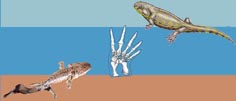Palaegeography of Tropical, Seasonal, Coastal Wetlands
Dave Millward (BGS), Sarah Davies (Leicester), Peter Brand (BGS), Mike Browne (BGS), Carys Bennett (Leicester),
Tim Kearsey (BGS), Janet Sherwin (Leicester), John Marshall (Southampton)
In December 2018, the Tw:eed Team published a paper in the journal 'Earth and Environmental Sciences Transactions of the Royal Society of Edinburgh' that shows an interpretation of the geography of southern Scotland and northern England during the 12 million years of the Tournaisian. The paper is part of a set celebrating the career and work of Professor Jenny Clack. The map is built from information gathered from selected exposures of the Ballagan Formation across the Midland Valley of Scotland and Northumberland, and from about 40 borehole logs in the BGS archives. It broadens the environmental interpretations in previous publications from the team established from studies of the Norham Borehole cores and the exposed section at Burnmouth.
The picture that emerges is of an extensive, low-lying, tropical coastal wetland with a marked seasonal climate, extending across the Midland Valley of Scotland, and separated from restricted marine environments in Ireland and across northern England by an archipelago of more elevated landmasses that included the Southern Uplands, the Cheviot Hills and several others across the Mid-North Sea High.
The south-west and north of the Midland Valley was dominated by perennial floodplain lakes with salinities that varied from brackish to saline and alkaline, interspersed with sabkhas and evaporitic lakes. A dominantly meandering river system intermittently occupied the eastern part of the region, depositing sediment south-westwards into the Northumberland - Solway Basin. The river belt appears to have hosted the greatest variation in environments, with juxtaposition of fluvial, floodplain, lakes and sabkha, hosting marsh and drier forested habitats. The wetlands were episodically flooded during tropical storms, with floodwaters funnelled into the south-west of the Midland Valley from Northern Ireland, and into the Tweed Basin from the Northumberland Basin.
Today, coastal wetlands are common across tropical regions, but the association of abundant lakes, including evaporitic bodies, and fluvial systems is unusual. Likewise this combination is rare in the geological record. The aerial extent of this Tournaisian coastal wetland is comparable to that of the Everglades in southern Florida today, though the range of habitats and, in particular, the flora were very different.
You can read the abstract of the paper online but the full paper can only be read by subscribers to the journal. My thanks to Dave Millward for preparing this summary.

Palaeogeographic map of the Ballagan Formation
© Copyright 2018 BGS and authors.

